Marmosets (Callithrix/Cebuella) are small monkeys that live in trees. Marmosets have a very distinctive smell, they actually use their scent glands to communicate. This makes it possible to identify themselves to each other. They have been kept by people as pets for several years but (unfortunately) a lot of the common marmosets are also used for medical research. On this site you will find all the information you need to know about keeping marmosets as pets.
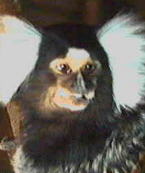 Common Marmoset (c) Johan Mommens |
 Pygmy Marmoset (c) Ivan Crab |
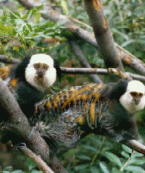 Geoffroy’s Marmoset (c) Ivan Crab |
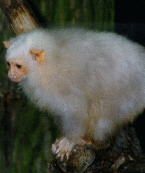 Silvery Marmoset (c) Ivan Crab |
| Marmoset Care Sheets
|
Marmoset Species:
|
Saying Goodbye
January 16, 2017 2:48 pm
By Mary Lynn Campbell
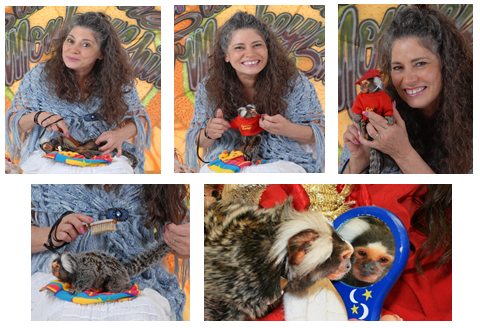
I spent the last part of this year trying to not only run a “Hospice-care” for my beloved Chewie, but to also try to prepare myself for loosing him. I hope after reading this “Special Topic” and seeing the photos, that you will know (without a doubt) it was truly a wonderful experience to have him in my life.
I am very thankful for this set of photos. We had so much fun together. He loved to have his special “brush-you” time during each show and of course his very special “mirror” time. Even with his smallness he knew he was the “special star” of the SunShine MonkeyShine’s presentations. I must also add that he knew he was the boss of the troop of Capuchin monkeys as well! He grew to love my troop of monkeys and I feel that his love for the troop made him wish to stay with us as long as he possibly could.
Chewie was not always called my little monkey but I did know him for his entire life. The years that we were with each other were so very special as I am sure you can see from the photos that I am sharing. When he was with us for our presentations, he was chosen by many as their favorite monkey that was there for the special event.
Posted in living with monkeys, marmoset, primate story, special topics, stories
How to diaper a monkey
March 1, 2015 5:45 am
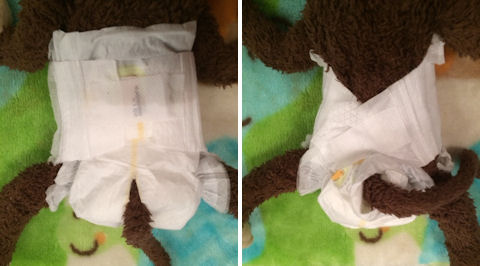
Amongst primate owners, the most commonly known method of diapering is the tail hole method but more and more primate owners are switching over to the tail wrap method. Since I’ve used both methods myself and don’t really have a particular preference, I reached out to other primate owners to find out why they prefer one method over the other. Before we go into more details, I’ve recorded a short video to demonstrate the difference between both methods. After that we’ll talk about diaper covers, different diaper brands, and what monkey parents are doing to prevent diaper rash.
Posted in baboon, bush baby, capuchin, chimpanzee, gibbon, macaque, marmoset, owl monkeys, primate care, savanna monkey, squirrel monkeys, tamarin
The kiss of death
November 14, 2012 2:29 pm

These are snippets out of the diary of Louie, our marmoset, with the hopes that it one day saves the life of another marmoset or tamarin.
It was September 2009 and we finally went to the long awaited exotic animal auction located in Macon Missouri. 4 times a year Lollibros organizes an exotic animal auction where you can find all kinds of exotic animals for sale, including primates.
After waiting for 6 hours, we were finally able to bid on a male common marmoset monkey. While the bidding process was a bit stressful, we eventually bought Louie below market value which was of course the reason we decided to buy at an auction instead of a breeder. There are risks associated with buying at an exotic animal auctions but it was one I was willing to take. On our way home Louie had a blast running around in circles exploring his new environment.
Arabic Gum
December 30, 2011 6:13 am
Marmosets (Callithrix/Cebuella) are small monkeys that live in trees. Marmosets have a very distinctive smell, they actually use their scent glands to communicate. This makes it possible more...
Posted in bush baby, enrichment, feeding, marmoset
Environmental Enrichment in Captive Marmosets and Tamarins
December 29, 2011 11:37 pm
By Dr. Hannah Buchanan-Smith
The author discusses the three main criteria which constitute a good captive environment. They are: good physical health, breeding success, and an animal’s ability to acquire and retain behavioral skills needed to cope successfully with his or her natural environment. Through her field studies, the author has learned that a variety in diet, innovative foraging devices, indoor/outdoor enclosures, natural settings, and a comfortable social environment are vital for the well-being of captive primates. She illustrates how altering conditions can promote natural behaviors in captive marmosets and tamarins. more...
Posted in enrichment, marmoset, tamarin